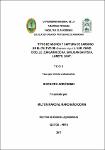| dc.contributor.advisor | Romero Villacrez, Juan Luis | |
| dc.contributor.author | Marchand Ocmín, Milton Marcial | |
| dc.date.accessioned | 2017-08-18T16:17:44Z | |
| dc.date.available | 2017-08-18T16:17:44Z | |
| dc.date.issued | 2017 | |
| dc.identifier.other | 631.86 M26T 2017 | es_PE |
| dc.identifier.uri | http://repositorio.unapiquitos.edu.pe/handle/20.500.12737/4867 | |
| dc.description.abstract | El trabajo de investigación se desarrolló en el Proyecto “Animales Menores” de la Facultad de Agronomía de
la UNAP, Distrito de San Juan Bautista, Provincia de Maynas, Región Loreto, donde se estudió tres tipos de
abono (gallinaza 30 t/ha, ceniza de madera 3 t/ha, gallinaza 30 t/ha + ceniza de madera 3 t/ha) comparado con
un testigo (sin abonamiento) para evaluar el rendimiento y la captura de carbono en el cultivo de “nabo”
Brassica napus L. var. chino criollo, utilizando un DBCA con cuatro repeticiones.
Realizado el análisis del suelo experimental se observó el incremento de la materia orgánica de 2.37 a 3.03%
en el tratamiento con gallinaza 30 t/ha + ceniza de madera, del mismo modo el pH subió de 4.23 a 7.04.
Asimismo, dicho tratamiento mostró el mayor rendimiento de raíz alcanzando 50.06 t/ha y el menor rendimiento
se observó en el testigo sin abonamiento con 5.56 t/ha.
El tratamiento con ceniza de madera (3 t/ha) alcanzó en mayor índice de área foliar de 238.47 cm2, siendo
estadísticamente significativo sobre los tratamientos con gallinaza + ceniza de madera y el testigo que
alcanzaron valores de 203.15 y 192.70 cm2 respectivamente. Al analizar la eficiencia fotosintética, el
tratamiento T4 (gallinaza + ceniza de madera) con 1.02%, fue significativo estadísticamente sobre los demás
tratamientos T2, T3 y T1 con 0.68, 0.66 y 0.51% de eficiencia fotosintética respectivamente. Del mismo modo,
el T4 alcanzó el mayor valor de captura de carbono con 1 722.38 kg/ha, el cual no fue estadísticamente
significativo sobre los demás tratamientos, siendo el cultivo de Brassica napus L. una de las especies vegetales
capaces de ayudar a reducir la contaminación ambiental por CO2. | es_PE |
| dc.description.abstract | The research work was carried out in the "Smaller Animals" Project of the Faculty of Agronomy of the UNAP, San Juan Bautista District, Maynas Province, Loreto Region, where three types of manure were studied (bird dung 30 t/ha, ash of wood 3 t/ha, bird dung 30 t/ha + wood of ash 3 t/ha) compared to a control (without fertilizer) to evaluate performance and carbon capture in the "turnip" cultivar Brassica napus L. var . Chinese Creole, using a DBCA with four replicates.
The experimental soil analysis showed an increase of organic matter from 2.37 to 3.03% in the treatment bird dung 30 t/ha + wood ash, in the same way the pH rose from 4.23 to 7.04. Also, this treatment showed the high performance root yield reaching 50.06 t/ha and the lowest yield was observed in the control without fertilizer with 5.56 t/ha.
The treatment with wood ash (3 t/ha) reached a greater index of leaf area of 238.47 cm2, being statistically significant on the treatments with bird dung + wood ash and the control that reached values of 203.15 and 192.70 cm2 respectively. When analyzing the photosynthetic efficiency, the treatment T4 (bird dung + wood ash) with 1.02% was statistically significant on the other treatments T2, T3 and T1 with 0.68, 0.66 and 0.51% of photosynthetic efficiency, respectively. Similarly, T4 reached the highest value of carbon capture with 1 722.38 kg/ha, which was not statistically significant over the other treatments, with the cultivation of Brassica napus L. being one of the plant species capable of helping to reduce environmental pollution by CO2. | en_US |
| dc.description.uri | Tesis | es_PE |
| dc.format | application/pdf | es_PE |
| dc.language.iso | spa | es_PE |
| dc.publisher | Universidad Nacional de la Amazonía Peruana | es_PE |
| dc.rights | info:eu-repo/semantics/openAccess | es_PE |
| dc.rights | Attribution-NonCommercial-NoDerivs 3.0 United States | * |
| dc.rights.uri | http://creativecommons.org/licenses/by-nc-nd/3.0/us/ | * |
| dc.source | Universidad Nacional de la Amazonía Peruana | es_PE |
| dc.source | Repositorio Institucional - UNAP | es_PE |
| dc.subject | Abonos | es_PE |
| dc.subject | Clasificaciones | es_PE |
| dc.subject | Captura de carbono | es_PE |
| dc.subject | Nabo | es_PE |
| dc.subject | Brassica napus | es_PE |
| dc.title | Tipos de abonos y captura de carbono en el cultivo de Brassica napus L. var. chino criollo, Zungarococha, San Juan Bautista, Loreto, 2016 | es_PE |
| dc.type | info:eu-repo/semantics/bachelorThesis | es_PE |
| thesis.degree.discipline | Agronomía | es_PE |
| thesis.degree.grantor | Universidad Nacional de la Amazonía Peruana. Facultad de Agronomía | es_PE |
| thesis.degree.level | Título Profesional | es_PE |
| thesis.degree.name | Ingeniero Agrónomo | es_PE |
| thesis.degree.program | Regular | es_PE |


